Spiky weeds are some of the most unpleasant weeds to find growing in your garden.
Their sharp thorns and prickles make the weeds difficult to remove. And they cause injury when you accidentally come into contact with them.
There are many different types. Some weeds have spines on their stems. While other weeds have spines on their leaves or fruit. And some of the worst offenders are covered in them from top to bottom.
It’s important to control these unwanted plants before they spread. So in this guide, I’ll help you identify the most common prickly weeds.
Bull Thistle (Cirsium vulgare)
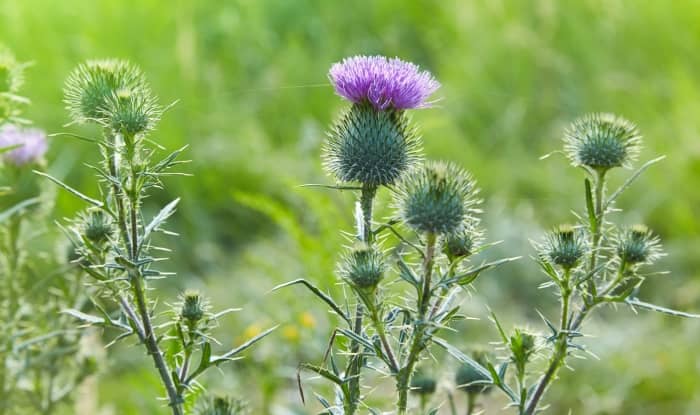
Of all the spiky weeds, thistles are probably the most recognizable. Bull thistles have spines that cover the leaves and stems of the weed up to the pink-purple flowers. They also have spiny bracts that grow beneath the flower head.
Bull thistles are biennial weeds. In the first year, thistles grow a basal rosette. With flat leaves that have big spikes down the middle and at the edges. In the second year, bull thistles develop a tall stem that can reach 7 ft. in height. And subsequently, flower.
You’ll find this prickly weed growing in various conditions and places. But thistles thrive in locations with good sun exposure and rich soil.
Jimson Weed (Datura stramonium)
Jimson weed is an invasive weed that’s a member of the nightshade family. It’s also known as thorn apple and devil’s snare.
Jimson weed produces a large fruit encased in a spiky capsule. But be careful not to eat it. Jimson weed is a notorious poisonous weed that’s dangerous when ingested. And just touching the plant can cause rashes. Making it a bad weed to find in your yard.
Jimson weed is a big weed that grows up to 6.5 ft. tall. The plant has green stems that are sometimes purple-tinged. And alternating leaves with toothed edges.
The plant blooms in summer. With trumpet-shaped violet or white flowers up until the first frost.
Prickly Sida (Sida spinosa)
Sida spinosa by Dinesh Valke from Thane, India, CC BY-SA 2.0, via Wikimedia Commons
Does the weed have a spike at its leaf nodes? If the answer’s yes, then you might be looking at prickly sida.
Also known as teaweed, prickly sida is a perennial herb. It grows up to 3 ft. tall on stems covered in fine white hairs. The green, heart-shaped leaves have a spine at their base. And they’re also covered in fine hairs that are easiest to detect through touch.
Prickly sida grows in full to partial sun, and moist, fertile soil. And from mid-summer to early fall the plant blooms. Producing small yellow flowers on flowering stalks that grow from the leaf axils.
Carolina horsenettle (Solanum carolinense)
Also called devil’s tomato, horsenettle is part of the nightshade family. The weed produces fruit that resemble small tomatoes. But be warned, horsenettle is a weed that contains poison and the fruit is toxic to eat. Just handling the plant causes a rash for some people.
Horsenettle emerges in the spring. And when fully grown, it reaches 3 ft. tall. Horsenettle weeds develop large thorns on the leaves and stems as the plant grows. The leaves are covered in hairs and have lobed margins. And they’re arranged alternately on the stems.
Horsenettle produces clusters of star-shaped flowers from May to October. Each flower consists of 5 white to pale-violet petals, with yellow anthers at the center.
It’s probably easiest to identify horsenettle by the tomato-like berries it produces. The berries are round and about ½-inch in diameter. And turn from green to yellow as they mature.
Common Cocklebur (Xanthium strumarium)
Common cocklebur has spines on its fruit. When the weed is mature, each fruit, called a bur, is about 2.5 cm long and covered with hook-shaped spines. The prickly burs easily hook onto your clothing or the fur of animals.
Common cocklebur is a summer annual weed that grows up to 4 ft. tall. Cocklebur grows in full sun to partial shade. It doesn’t grow in full shade. Each cocklebur plant produces hundreds of burrs. Allowing seed dispersal to areas far away as the burrs are carried.
You also might come across a closely related plant called spiny cocklebur. It’s a very similar weed, but it has spines on its stems as well as the fruit.
Goat Head Weed (Tribulus terrestris)
Goat head weed by A.Davey
Goat head weed is also called devil’s thorn, puncturevine, and bindii. It’s notorious for the sharp barbs on its fruit. These vertical spikes resemble horns, and easily puncture thin shoes, bare feet, bicycle tires, and the hooves of animals. This allows the seeds to be carried to new locations. And so the plant spreads.
Goat head weed is a creeping weed that grows low to the ground. With long hairy stems that grow up to 5 ft. long. Forming a dense mat as they spread out from a central taproot.
Goat head weed is a fast-growing noxious weed. It germinates in the spring and starts flowering within 3 weeks. Producing yellow flowers from April through to October. After the flowers bloom, the weed produces the small spiky fruit.
Lawn Burweed (Soliva sessilis)
Lawn Burweed by Harry Rose
One of the pleasures of having a lawn is feeling the grass under your bare feet. But you better be careful if lawn burweed is in your yard. This weed disperses prickly thorn balls that will give you a nasty surprise.
Lawn burweed is a creeping weed that grows in your lawn. It’s an annual broadleaf weed that grows in thin and patchy turf, germinating in the fall and growing through the winter. When the temperature starts to warm in early spring, lawn burweed produces small spine-tipped burrs. With a seed in each hooked burr.
Lawn burweed is also called stinging grass because it stings when you step on the spiky balls. Other names for lawn burweed include spurweed, field burweed, and bindi weed.
For more weeds with burrs check out our guide.
Brambles (Rubus)
Brambles are weeds with thorns on their stems. These prickly shrubs are usually from the genus Rubus and include well-known plants like the blackberry bush and raspberry bush.
Although some gardeners grow them in cultivated landscapes, brambles also grow wild in neglected areas. Forming dense bramble thickets of impenetrable tangled stems. Brambles grow best in sunny locations but still thrive in partial shade. And develop arching stems that grow up to 8 ft. long. Bramble stems are stiff like canes and root in places where the tips touch the soil.
Brambles don’t flower or produce fruit until their second year of growth. But when they do, you’ll notice the bright juicy berries that are popular with people who forage.
Prickly Lettuce (Lactuca serriola)
Also called wild lettuce, prickly lettuce is a member of the dandelion family. The weed has flat spiny leaves with prickly bristles on the edges. And a row of bristles along the lower midvein.
Prickly lettuce is a biennial or winter annual weed. It’s a tall weed that develops a thick stalk, growing up to 6 ft. tall. With green, egg-shaped, lobed leaves, that alternate along the central stem. Between April and October, prickly lettuce blooms. Producing small yellow flowers that resemble dandelion flowers.
The leaves of prickly lettuce are edible when the plant is young. The leaves have a mild flavor and go well in a salad. But older leaves become bitter, especially after the plant flowers.
Spiny Sowthistle (Sonchus asper)
Also known as prickly sowthistle, spiny sowthistle is an annual weed. Identification is easy. The weed has spiny leaves with prickly margins. And produces yellow flowers that look similar to dandelions when the plant blooms. If you’re trying to identify a spiky dandelion weed, then there’s a good chance it’s spiny sowthistle.
Despite the name, it isn’t actually a thistle. But in the early stages of growth, it develops a basal rosette that looks very similar, leading to confusion.
Spiny sowthistle grows in full sun, and moist to dry soil. And you’ll often find this weed growing in lawns, landscapes, hayfields, pastures, and around roadsides.
Common Greenbrier (Smilax rotundifolia)
Common greenbrier by Judy Gallagher
Also called catbrier, common greenbrier is a spiky weed with long thorny vines that grow up to 25 feet. The vines are hard, green canes that grow along the ground and climb over obstacles. Large, black-tipped thorns protrude from each vine.
Between May and June, greenbrier produces clusters of yellowish flowers. And sets fruit from September to October. Producing black berries in globe-shaped clusters.
Common Teasel (Dipsacus fullonum)
Teasel is a tall weed with spines on its stems and leaves. Prickly bracts curve upwards forming a cage around an egg-shaped, spiny flower head.
The leaves grow alternately along a tall flowering stem that rises to 6.5 ft. tall. And when teasel flowers, it produces tiny lilac to lavender flowers.
Teasel is an annual weed. And after it produces seed, the plant dies and turns brown. The seeds don’t spread far from the parent plant. So teasel often forms dense colonies over a large area.
Litchi Tomato (Solanum sisymbriifolium)
If you’ve found a spiky tomato weed, there’s a good chance it’s litchi tomato.
Also called sticky nightshade, litchi tomato is a spiky weed with red berries. The appearance of the fruit closely resembles a tomato. And some people mistake this weed with a tomato plant.
But there are some obvious differences:
To start with, green spiky pods encase the red berries. The pods shrink and lose their color as the fruit mature. And they grow at the end of green stems that are covered in sharp spikes.
Litchi tomato is a giant weed that grows to 8 ft. tall. And it’s a bushy plant, often growing wider than it is tall. When it blooms, litchi tomato produces star-shaped white flowers. The weed likes growing in full sun. But can also grow in partial shade.
Spiky weeds are a common type of weeds that you usually don’t want in your garden. But some people choose to grow litchi tomato. Why?
Firstly, the fruit are edible, tasting somewhere between a cherry and a tomato. And the spiky plants can make a good hedge plant between your garden and the outside world. Discouraging wildlife from coming onto your property.
Prickly Paddy Melon (Cucumis myriocarpus)
Prickly paddy melon by Peripitus, CC BY-SA 3.0, via Wikimedia Commons
Are you trying to identify a spiky melon weed?
Prickly paddy melon is a weed that grows along the ground. The plant produces round, green-yellow melons, covered with soft spines. The leaves are light green and deeply lobed. And when it blooms, the weed produces small yellow flowers.
Prickly paddy melon usually grows in disturbed soil. And you’ll often find it in bare or cleared areas.
The fruit give off an unpleasant smell when you break them open. And fortunately, this puts most people off eating them, because the fruit is toxic to people and animals.
Spiny Pigweed (Amaranthus spinosus)
Also known as spiny amaranth, you’ll often find spiny pigweed growing in heavily grazed pastures and hayfields. Spiny pigweed looks similar to many other species of pigweed. But you can identify this weed by the spines on the stem. There are two needle-like spikes at each leaf node, at the base of the leaf.
Like other weeds with needles, it’s easy not to notice the spines, so be careful when touching the plant.
Spiny pigweed is a summer annual weed that grows up to 5 ft. tall. It has hairless leaves that grow alternately along the stem and are diamond-shaped to egg-shaped. The plant has both male and female flowers. The male flowers bloom on a terminal spike at the end of red stems. With the female flowers growing in the leaf axils at nodes.
Balloon Plant (Gomphocarpus physocarpus)
The balloon plant is a member of the milkweed family. The plant produces easily identifiable lime green, spiky seed pods. The spines are soft and resemble long hairs, leading to the balloon plant’s nickname of ‘hairy balls’.
This spiky milkweed plant grows up to 6 ft, high. With yellowish-green branches growing from a central slender trunk. The light green leaves are smooth and grow in opposite pairs. With each leaf about 3-4 inches long and lance-shaped or oblong. In the summer, clusters of white flowers appear at leaf axils, each with 5 petals.
All parts of this weed are poisonous due to the milky white latex inside the plant.
Burr Medic (Medicago polymorpha)
Burr medic by John Tann
Is your lawn filled with prickly burrs? If so, you probably have burr medic growing in your yard.
You can identify burr medic by its red-purple stems and green leaves with serrated edges. Flowering takes place from March to June. With small yellow flowers arranged in clusters of 2-10 flowers at the end of stems.
After flowering, this burr weed produces small green fruit with hooked prickles on the outside. These quickly dry up and turn brown. Then they spread, dispersing the seeds around your garden.
How Do You Get Rid Of Spiky Weeds?
Getting rid of spiky weeds in your backyard can be challenging. But, you can often pull them by hand when the weeds are young. Because of the sharp prickles, it’s important to protect your hands by using gloves suitable for thorns.
Make sure you remove all the roots and rhizomes. Many weeds regrow from any parts left behind in the soil.
If natural methods of control fail, chemical herbicides are the most reliable option.
You can find detailed methods for spiky weed control here: how to get rid of prickly weeds.

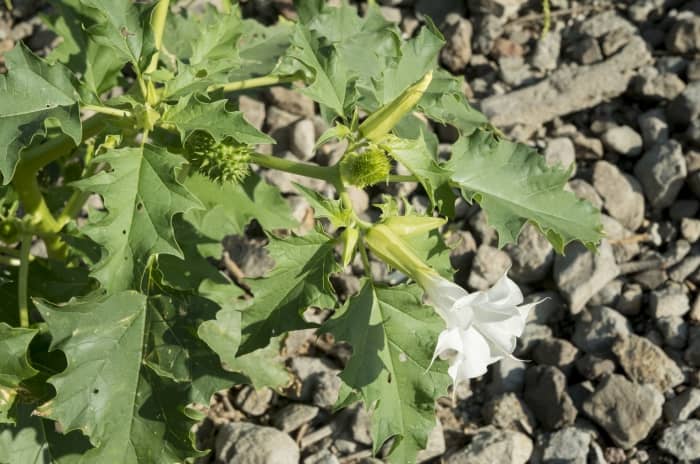

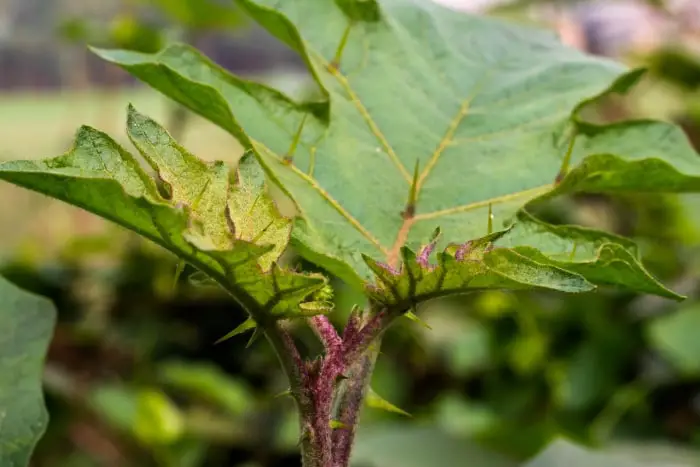
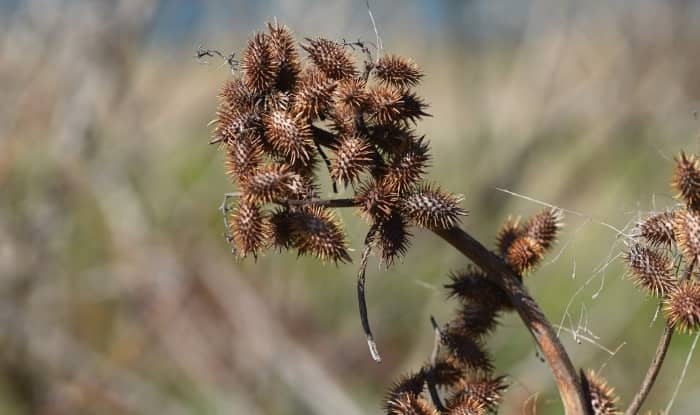
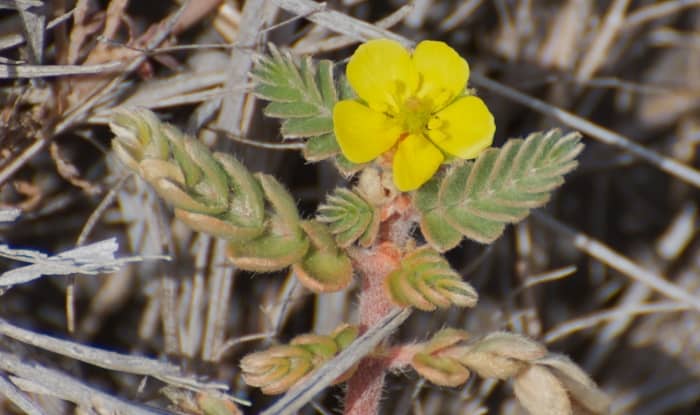
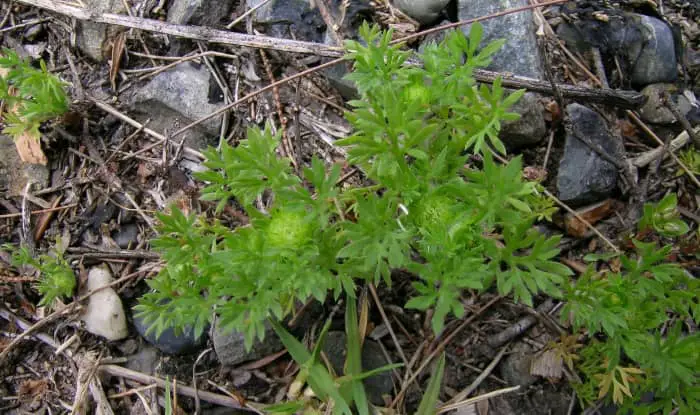
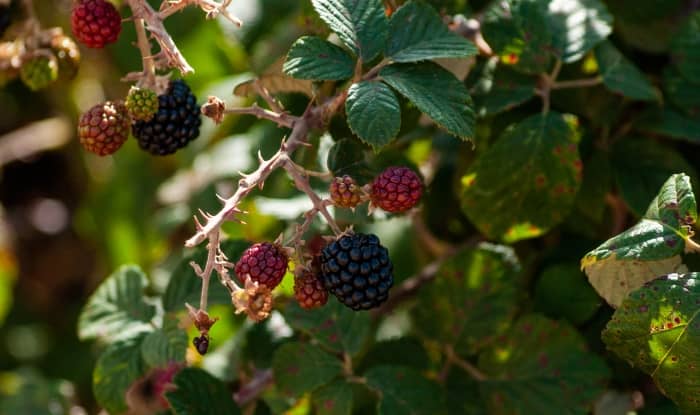
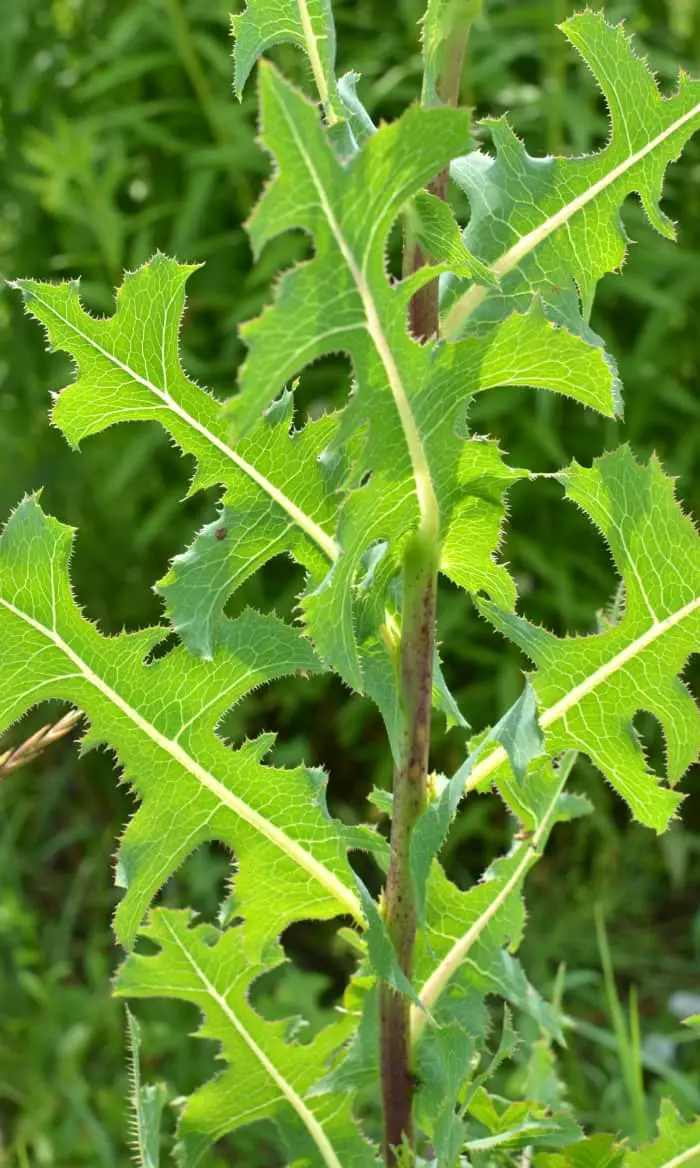
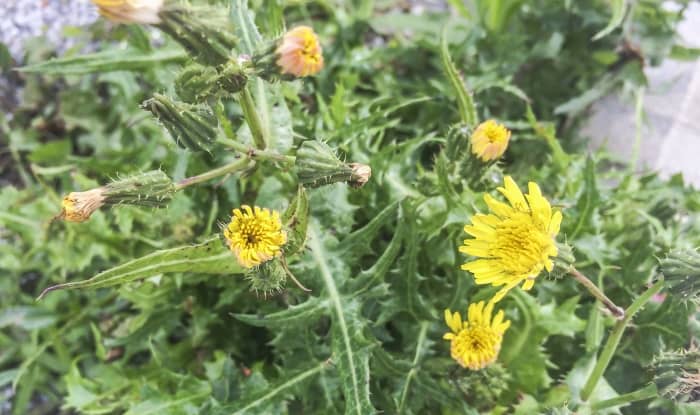
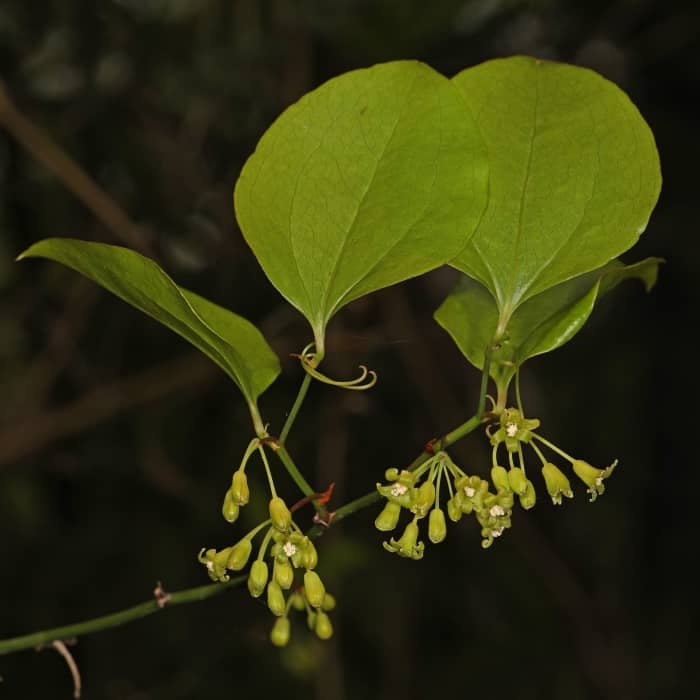
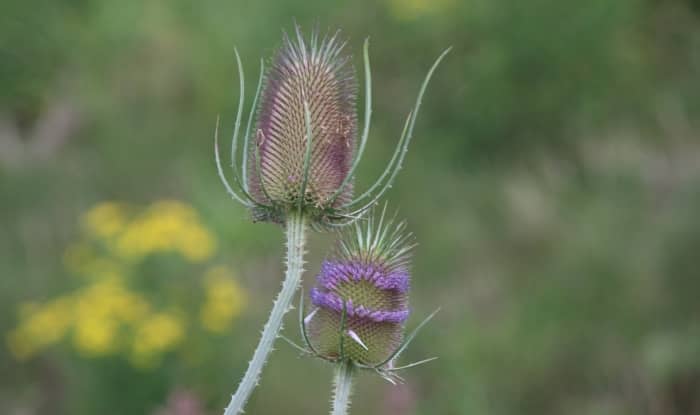
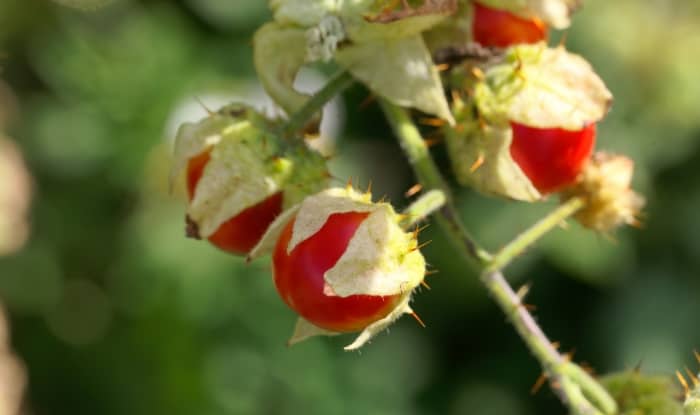
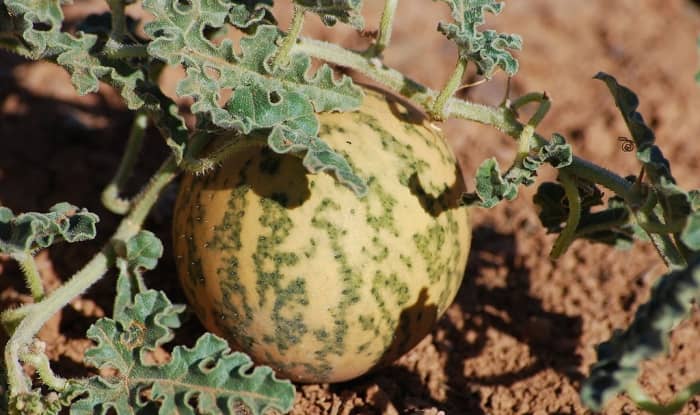

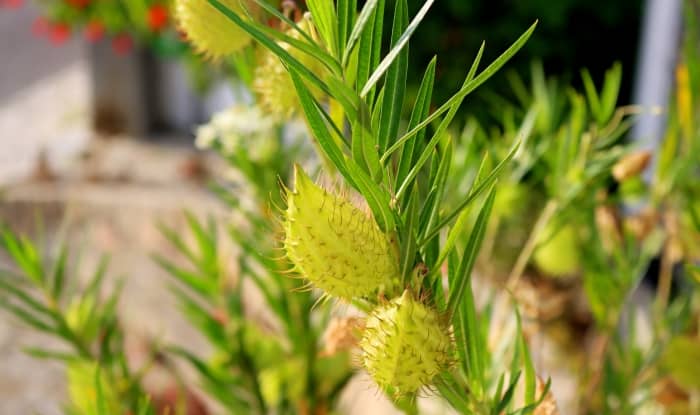
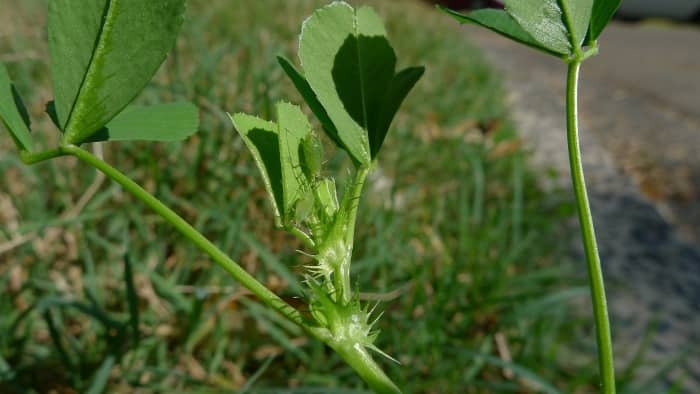
found a very small prickly round shaped weed
very very dry ,tiny seeds on each little sharp thorn,
as many as 10-12 thorns. very dangerous, hurts
when in contact, never seen before
Sounds like what is called lawn burrweed here. I found it under Burr Buttercup. It has fine roots and the leaves look like moose antlers or like hands. The burr kinda looks like a miniature pineapple. Physical control seems to work best if you can get to it before the burrs start to dry out.
Alan
Was looking for a plant with pods not entirely unlike wild radish, only smoother pods and instead of the fiddle shape leaves this has long strong serrated spiky leaves. Does anybody have any ideas?
I was picking up sticks from our backyard and I felt something in my hand when I looked it looked like I had fine whiskers growing out of my hand ,we live in N.S.W, Country Town never in the 11 years we have lived here have I had this happen before and I’m always pulling out weeds or getting fallen sticks off the ground ,I managed to get some out of my hand but others are so small ,hope you can help .
I can’t help with the weed but may help with the spines. I have used tape, usually colored electrical tape such as Scotch 35 on any thorns I couldn’t see or get out right away. The tape covers the sine or thorn so it isn’t catching on everything. It also holds moisture in and seems to make it easier to pull the thorns out and the tape will pull some out when carefully removed.